Israel’s Sanhedrin Confirms the Mystery of the Shemitah
With shofars blasting, Rosh Hashana this year included a biblical commandment Jews haven’t executed in nearly 2,000 years: actually counting the Jubilee.
“It is a simple mitzvah, reciting just a few lines, but performing this mitzvah is a declaration that the prophesied return of the Jews to Israel has been fulfilled, thereby establishing a basis for the rebuilding of the Jewish Temple,” BreakingIsraelNews.com reported.
“To begin counting the Jubilee last year, the Sanhedrin, as a bet din (rabbinic court), ruled that the Jews have returned to inherit the land as a nation, and not just as individuals. This requires at least 600,000 Jews, equal to the number of Israelites that returned to Israel from Egypt under Joshua.”
Jonathan Cahn, author of The Mystery of the Shemitah, told me he was led to include a chapter on the Seventh Shemitah, the Jubilee—particularly the Prophetic Jubilee.
“I set the start of that Jubilee with the holy days of September 2015,” he explains. “To hear now that after 2,000 years, the Sanhedrin of Israel has declared the restoration of the Jubilee is amazing. And to hear, on top of that, they reckoned the Jubilee as beginning with the holy days of September 2015, the same time as in The Mystery of the Shemitah is stunning.”
In a chapter of the book called “The Mystery of the Seventh Shemitah,” the prophetic Jubilee is opened. Cahn explains how every seventh year was the Sabbath Year or the Shemitah and every seventh Shemitah, or 49th year, ushered in the super Shemitah known as the Yovel, or the Jubilee.
“During the Jubilee if you lost your land, your home, your family inheritance, your ancestral possession—in the year of Jubilee, you would get it back, you would return to it,” he says. “The Jubilee was the year when the land was restored to the people and the people to the land.”
How does this apply to today and why is the counting of the Shemitah so significant?
“Two thousand years ago, the Jewish people lost the land of Israel and their holy city Jerusalem, their ancestral possession. For the children of Israel to be restored to the land of Israel would be a prophetic Jubilee,” Cahn explains. “So could the ancient Jubilee hold the key to that restoration? No one knows when the Jubilee is, as we have no record of its celebration in the time of Messiah. But we do know when the Shemitah is. And that’s the key. The Jubilee must take place in the year following the year of the Shemitah.”
Cahn goes on to explain how the Shemitah ended in September 1917 in the First World War. Thus, he says, the Hebrew year following the Shemitah, began September 1917 and ended in September 1918.
“Did anything significant in Jewish history take place in that period—anything involving the restoration of the Jewish people to the land? It was precisely in that period that the land of Israel was freed from the Ottoman Turkish Empire by the British,” Cahn says. “In November 1917, the British Empire issued the Balfour Declaration restoring the land of Israel to the Jewish people and the Jewish people to the land of Israel—Jubilee—a prophetic Jubilee taking place, as it had to, in the year following the Shemitah.”
Cahn explained to me that if one counts seven Shemitahs, 49 years later, one comes to the seventh Shemitah which ends in September 1966. The following period, September 1966 to September 1967, would be the prophetic Jubilee, the year of restoration.
“Did any significant event during that time—any event linked to a prophetic restoration?” he asks rhetorically. “It was precisely in those time parameters that Israel in the Six Day War, was restored to Jerusalem, its long lost ancestral possession—Jubilee. Though nothing has to take place in every cycle, it is worth nothing that the next Jubilee would begin in September 2015 and extend into October 2016—It is this exact period that the Sanhedrin of Israel has now declared to be the Jubilee.”














































